| A
Weekly Outlook and Analysis of the Global Investment Climate November 20, 2000 |
Running
Out of Band-Aids
Printer
Friendly Version
It
certainly is interesting to observe the financial 'community' try and
tell people that a currency intervention will not work without it being
internationally coordinated - meaning that it has to include help from
the Fed. This is the equivalent of psyching out the opponent by telling
him that he will lose, and it coincides with the implicit aim of the US
Treasury, which is to jam the dollar higher… in order to fight the oil
inflation! There is a race going on… no, it's more like a fight… between
the global fiat exchange value of the US dollar (dollar versus euro for
example) and the objective (real) exchange value of the US currency (in
relation to tangible staples such as oil). So far this year, the purchasing
power of the phony fiat dollar rate has lost ground against important
world commodities. But you have seen us post those charts many times already.
What if…
…and I am a speculator, so you may expect that I
will make speculations on occasion… I just can't help it. Rest assured
though, as I always provide a valid reason for the existence of any speculation…
Anyhow, what if the Fed (or Treasury) has been selling off its excess foreign currency holdings to help the dollar along? Evidence? We have none, only the drama implicit in the four currency charts, which we present further down below. But we have summoned up a strong motive implicit in the first paragraph. Just for fun, let's briefly consider how…
They could easily disguise it with legitimate transactions such as would result from the execution of a hedge program, presumably developed to sterilize (read front run) some up and coming European-US acquisition spree. Or in order to smooth 'potential' risk-averse liquidity outflows from Canada or Australia, which might interfere with Fed policy, they might sell some loonies here in order to absorb the supply later. Is it their fault that it just so happens to be in their interest at the moment even if it is bad timing for Canada, or Australia, or Europe, or the UK? Really though, I think we know that they don't even have to disclose it if they choose not to.
The point is that if the ECB asks the Fed for its part in a coordinated currency intervention, it ought not be surprised at Mr. Greenspan's smile, for when it does so, it is only signaling to its chief monetary adversary when to temporarily cover its short. So if sometime in the near future the ECB begins to act on its own (beyond election time) in the forex market, disregard the explanation that the US propaganda machine assigns to it. The reality is that the ECB will be demonstrating confidence in itself and distrust of the Fed.
Pleading or Warning?
US authorities have been making the rounds to rally OPEC support behind
helping to lower oil prices.
According
to Bloomberg:
``Twenty
to $25 seems to be catching both producers' and consumers' strong support,''
U.S. Energy Secretary Bill Richardson said, adding that market forces
should determine prices.
Yeah... Ok Bill. If market forces should determine prices, then what the heck is Richardson doing trying to intervene in the first place? And what is Gore doing by selling emergency oil from the US Strategic Petroleum Reserve? Why do they keep "acting" on the illusion of an oil shortage, when our own people tell us that there is really only a shortage in natural gas/ heating oil markets? Why the heck do they keep selling their foreign exchange reserves to battle the oil inflation?
Later, an overnight report by the BBC suggested that Richardson's strong warning had turned into a plea, which OPEC had no real desire to entertain. Also, and maybe more importantly, the report also said that:
"However, the European Union's energy commissioner appears to be at odds with the US. Commissioner Loyola de Palacio told the BBC in Riyadh she believed there was no real shortage of oil on the world market."
Now this is truly interesting! Think about it. The American propaganda machine has been talking about an oil shortage in the United States and in Europe, where oil prices have risen even higher (in Euro terms), yet the European energy minister says that there is plenty of oil on the market. Go figure. Oddly, it was reported earlier by Bloomberg that both US and European authorities sent a strong warning to OPEC... but now, the BBC paints a completely different picture. What is it… does the Treasury write articles for the major business magazines on this continent now or did Big Larry say something to set the Europeans off.
A GoldenBar Review
Wall Street bulls put in a noble fight off of the mid October low, but
that rally is undergoing its test as I write this.
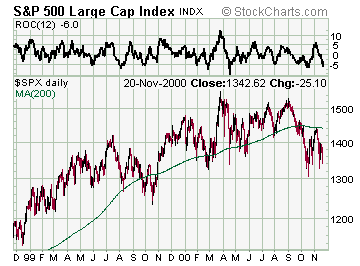 |
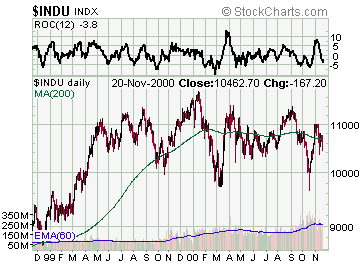 |
|
S&P500
Large Cap Stock Index
|
Dow
Jones Industrial Average
|
In an attempt to clarify our hypotheses, allow us to review our intermediate expectations. We suspect that the oil problem is really a dollar problem and believe that we have provided enough evidence to make that a strong argument. Hence, we had expected and fully expect that the US Administration will continue to apply one Band-Aid after another on a brewing storm, which has much more to do with dollar inflation and much less to do with "oil" supply imbalances than Uncle Sam is letting on.
So far, as expected, oil prices continue to rise even after uncoordinated (pun is seriously intended here) government interventions. Please refer to our October 16, 2000 GIC EasyMoney for a recap if you need to. We have also been bearish on US/global equity markets for 12 months now, and clearly, correctly so.
Also at around mid October, we presented you with our hypothesis that the sell off marked the point of recognition for a primary stock market bear but we expected too, that this signal be reacted to (or fought) with a derivatives led index rally. We guessed that the rally would naturally occur in the most volatile and oversold sectors, which they did, but not precisely where we thought that they might. All in all, we are not too surprised by what has been going on. We have watched the US stock markets rally, without much muscle as expected, and this in the midst of an annihilation of value in US corporate credit markets. We perceived the "expert" nonsense to be rising in volumes, and we continue to see the broad stock market in decline while Wall Street still favors the stock picking (dart throwing) approach. Indeed, these conditions suggest to us that we haven't arrived at the bottom quite yet.
However, we were not prepared to accept that US capital markets would be allowed to fight back at the expense of other weaker fiat currencies. We were not prepared to accept the lengths that the US government would take to avoid understanding how to better inform foreign investors about the (dollar) inflation component in oil prices (among other things).
Instead, the government prefers to tell investors that the dollar is gaining because of this that or the other thing, but basically that it is a "relative" SafeHaven. We are also amazed as well as amused that the Fed is as oblivious to the inflation argument as it is oblivious to the stock market bubble, real estate bubbles, and to the overall levels of systemic credit and indeed, financial system risk. Perhaps I should not be surprised but I am, seeing that in the case of oil, the demand/supply imbalance that Mr. Greenspan is trying to focus our attention on remains an inadequate explanation for the "enormous" rise in oil as well as other commodity prices. What concerns me about this is that if this is a monetary phenomenon, and the Fed says that it does not see it that way, then where is our anchor?
In any case, the bulk of the data suggest that these are no longer the days when the wind was at the back of US dollar policy, and that is why we were surprised to see how hard they (yes there is a they in the currency business) have been able to rally the dollar over the past three months. I do expect and contend that we are at a major turning point for the dollar and in Declining Dollar Utility, I tried to illustrate my argument, even as the (fiat) foreign exchange value of the dollar, represented by the dollar index, has risen from 105 in mid June to just under 118 today.
That's a hefty rise... a little over 12%, on average, against a trade weighted basket of currencies in only five months. No, I did not expect that. But I also would not have expected ahead of time that were it to do that, that the price of oil would still outpace it by rising 13% over the same period, and especially if I knew how many bullets the Fed, the media, and the administration were going to actually use (intervention). And despite all of that and OPEC's intended statement that there is actually too much "oil" supply in the market, as well as the European energy commissioner's position that there is plenty of oil on the world market, here we are at $35 oil. Now you tell me if we are hitting the nail on the head or not.
Still, I am beginning to sense that it is timely to discuss what might stop this powerful train from igniting widespread inflation "expectations."
So, what is their next move?
There are three basic maneuvers, which I can immediately perceive. First,
they can do as we speculate that they do… that is, sell foreign currency
reserves and inflate the fiat value of the dollar. But because I think
that they have stretched this dollar melt up about as far as it will go,
and because it seems that foreign interests are beginning to diverge,
and finally because it seems as if the Fed/Treasury is running out of
Band-Aids, I would place a relatively high probability on a hard politically
contrived shock to alter the US financial system. Ironically, the least
likely move to occur is likely the most effective. It will be to raise
interest rates with the explicit intent of soaking up excess dollar supply,
but it is really their last resort. They do not have the resolve, in my
opinion, to move interest rates to the kinds of levels that will correct
the situation and even if they did, this kind of move at this point risks
igniting a complex set of unstable macro relationships, which outcome
nobody can really be sure about.
The way we see it is that world stock markets are falling apart, the world economy is slowing faster (get it), and the Fed is hoping that the public has bought the line about demand side economic arguments. This way it can manage public inflation expectations better. Illusion and deceptive reporting are working to a degree in confusing the public, but these are only soggy Band-Aids.
The basic idea behind using aggregate demand side economic explanations for inflation is that you will (hopefully) perceive an economic slowdown or stock market correction will cool the pressure on oil prices and more generally, inflation. At the same time, the Fed must be literally (praying) hoping that this is what will happen, because so far it isn't... which is what the statement, which accompanied the last FOMC, meant by the way. And it is what we have told people that it is all along... inflation.
In reality, of course, you cannot have a rise in aggregate demand, which exists independently of the influence of demographic (or population) changes. Not even productivity gains can produce a rise in aggregate demand and especially not if there is a stable monetary unit of account. It should not be any wonder then, that there is a strong correlation between money supply and economic growth as measured by the GDP... they are the same thing, but filtered through different theoretical models.
On the contrary, in a theoretical economy using an anchored monetary policy, productivity ought to generally induce a humming supply side expansion through a virtuous cycle where prices of goods generally decline and the objective value of money actually rises because consumers prefer to save rather than to spend, thus lengthening the production cycle through a real investment led expansion in wealth. I know it sounds to good to be true.
In any case, this really is the true virtuous cycle. But as is the case with the deceptive economic term stagflation, it is thus also the case with this concept about aggregate economic demand. They are contrived, not for your benefit. More importantly, there is no statistic (be it the CPI, the core CPI, or the GDP price deflator), which can separate for you, how much of a change in the price of something has to do with the consequence of inflation and how much has to do with a properly functioning price mechanism, or vice versa.
The Fed and/or Treasury just haven't told us that yet, probably because they have yet to deal with it themselves. That is one heck of a potential moral hazard, wouldn't you agree? Or possibly because, as Heizenberg might say, the act of stating the uncertainty would induce an inappropriate inflation expectation set.
Every war is won before it is fought
The point of the preceding paragraphs was really intended to illustrate
that the world monetary infrastructure is not prepared for an honest statement
from the Fed. It could not handle the truth, so to speak.
Yet even as US authorities have thrown everything that they have at the oil market, and have contained inflation "expectations" reasonably well so far, they have actually been losing this oil war so far.
While Mr. Greenspan explains the oil "hoarding" behavior, which he observes in Europe by suggesting that this potentially represents future supply, oil prices move higher and the hoarding continues.
While the US administration misuses its Strategic Petroleum Reserve to hammer oil prices, and the US Treasury concurrently plays world dollar domination - taking down the Canuck Loony and the Aussie Dollar (to name only a few) in the process - even then, oil prices head higher.
Now are we beginning to get a sense for the appeal of a hard asset?
So the stage is set...
What can policymakers do, which will affect a stronger pressure against
oil prices than anything that they have done so far? What is their next
move? Do they have it within their capabilities to take this thing to
the next extreme? I really don't think so… I think we are there.
The health of US equity markets over all probably provides a good account of the nation's current state of affairs (or economic clout) looking forward, and the fact remains that they have few "non boat rocking" options left to deal with on this oil problem.
So, what if I am right then, and US authorities are selling their foreign currency reserves to support the dollar, bond, and perhaps even the stock market... what if they step on the gas and push this thing as far as it will go because that is what has worked for them so far? I am not saying this for any other reason than to provoke some thought about a possible outcome in financial markets as the result of some legitimate real world assumptions.
Anyhow, the likelihood is that by doing this, they will (or ought to) raise the hairs on the backs of investors who live in the countries that will be on the other end of that stick, as their currencies implode... The pressure could conceivably become intense enough that it breaks the Euro, Pound, Canadian dollar, Aussie dollar, or even the Yen (by break I mean it collapses the economy in the process).
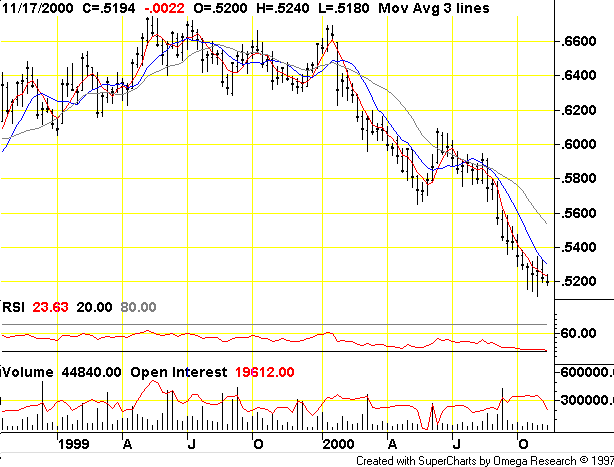 |
|
|
Australian
dollar
|
Canadian
Dollar
|
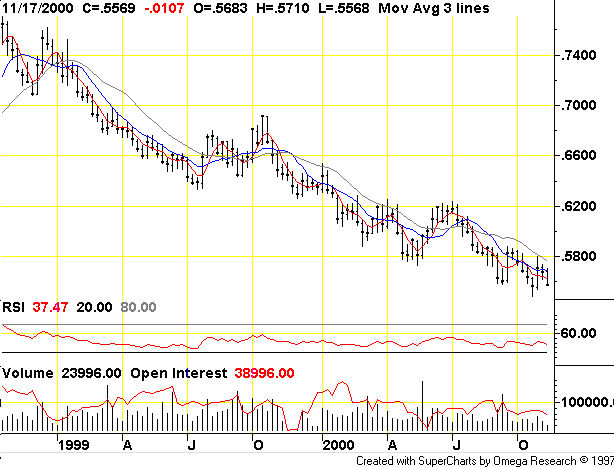 |
|
|
British
Pound
|
Swiss
Franc
|
This would of course accelerate inflationary forces in these countries and outside of the "Island of Prosperity," which would in turn only help to solidify the buildup of inflationary forces in the USA as the crisis led external demand for dollars would not only stimulate US markets, but would stimulate further increases in dollar (money) supply and credit. The errors in this kind of move are many. For instance, if the problem in oil markets is one of dollar inflation in the first place, then what happens when the crisis becomes anticlimactic and demand for dollars ebbs again? The consequences intensify.
The Message of US / Global Equity Markets
is Not Good
After the late October rally and since early November, equity bulls have
been losing their footing again. Last week's dead cat bounce in the S&P,
Nasdaq, Amex, and NYSE composite was the most they could muster after
giving up most (if not all) of October's temporary gains in only the first
week of November.
The Dow averages look the most resilient to all of this, but there too the Industrials only ended up 26 points on the week and the chart resistance at this level may prove insurmountable now, especially while the broad market continues to decline. The minor advance in the NYSE advance decline line only retraced 1/3 of what it lost in the September/October rout and furthermore, there is an offsetting deterioration (new lows) in the Nasdaq and AMEX advance decline data. It is significant enough to resolve bearishly for those indexes in particular.
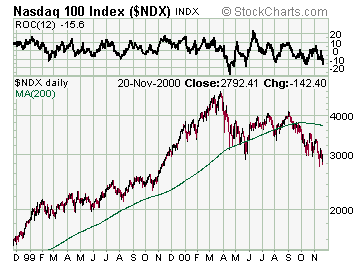 |
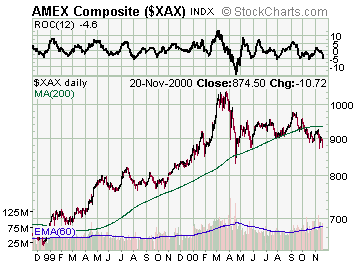 |
|
Nasdaq
100 Index
|
AMEX
Composite Index
|
If the bulls hadn't already tried so hard at stirring a rally, I might have been able to convince myself that one was in the making. But that isn't the case, and yet the stock markets landed on their butts last week… apparently because investors didn't know how to interpret the FOMC policy statement.
That being said, as I browsed through my charts this week, I began to wonder if traders have begun to focus on resistance points yet, rather than support points?
Leaders and Losers
Boeing, Phillip Morris, Caterpillar, Minnesota Mining, Procter Gamble,
and United Technologies are set to continue the Dow leadership this week,
while Merck, American Express, Alcoa, Eastman Kodak, International Paper,
Microsoft, JP Morgan and SBC Communications look set to give up some of
their recent gains.
AT&T, and Disney's stock looks as if they want to trade toward zero. The General Electric market appears to want to confirm a break from an eight-month rising wedge (from March to October). And IBM appears to be setting up to challenge resistance at $105. The rest were either difficult to interpret or neutral.
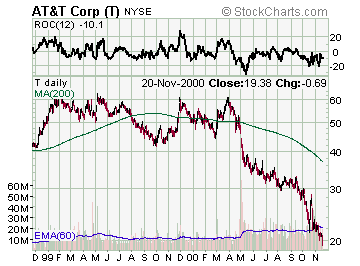 |
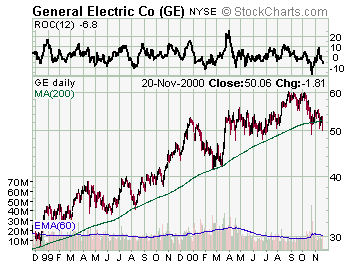 |
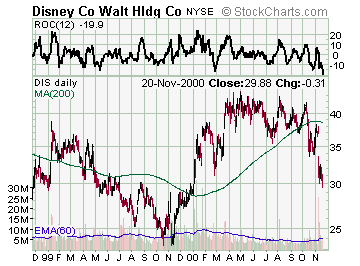 |
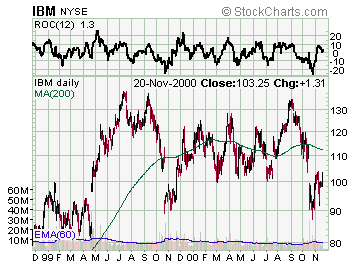 |
Now look at the components, which 'want' to lead this average the most again this week. They are generally companies that produce real goods. Companies, whose business is intact, yet were left behind in this great US bull market. Is the market moving into a perceived SafeHaven, or is Wall Street throwing Goldilocks silently to the wolves while it buys stock, which will benefit from an inflation breakout… see WallStreet Kisses Goldilocks Bye-Bye.
The sectors that were hit most on Friday (Banks, Biotech's, Telecom, and the XAU) are likely to lead the market lower this week. Ever more this market is again looking like a very heavy load on a long and very dry plank… the message of the markets is not good, so to speak.
Overseas
The French CAC and the German DAX also seem to be having problems around
their 200-day moving averages, though I should say under it. The weight
of October's sell-off dragged the 50-day moving averages in Europe through
the 200-day, about seven trading sessions back. But here too, the action
of the index around these "average" levels has shifted sufficiently so
that it has become obvious that they have begun to exert a bearish influence
on the direction of these moving averages. Or in other words, the 200-day
moving averages suddenly seem like insurmountable resistance areas to
overcome.
London's FTSE (stock index) and the Sydney All Ords Index, on the other hand, appear to be gaining back some of their momentum, and in particular, relative to the S&P500. Indeed, they are showing us how stimulative (to trade) a collapsing currency can be.
Meanwhile, a "bifurcated" market environment has gripped Asian stock markets as the Hong Kong market trades like the European markets and the Japanese stock market trading like as if it were forecasting an earthquake. Mums the word.
The commodities indexes (CRB and the GSCI T/R) have bounced firmly off of trend support and have basically behaved opposite to the stock markets last week, as they erased most of the early week's losses by the weekend. Hmmm. The move in commodity markets is rather broad but it excludes the precious metals markets... hmmm, especially silver prices, sugar/cocoa, and the industrial products markets (which are more an indication of economic "activity" than they are a standard for objective dollar valuation). In fact it is broad enough to support an unfolding bull market for certain relatively scarce commodities, such as gold, oil/gas, platinum, palladium, and food staples.
Have a look at agriculture prices and tell me how bullish that looks to you. I would look here to explain some of the recent leadership in US stock markets. The same can be said for cattle prices, cotton markets, and even copper prices until just recently anyway.
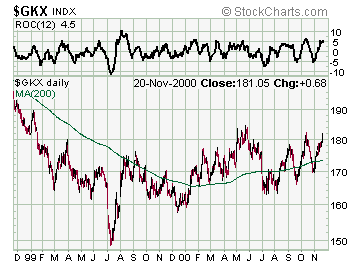 |
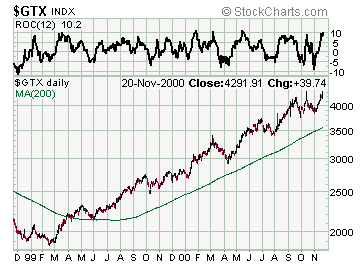 |
|
Goldman
Sachs Agriculture Index
|
Goldman
Sachs Commodity Index T/R
|
Mixed Messages
Yet despite all of this, CNBC's anchorman Ron Insana said that we were
not supposed to worry about inflation, in his teaching debut on his "Message
To The Markets" Thursday afternoon. Why not, he probably gets his "tips"
from big Jack. Anyhow, after spending a little bit of time on the subject
of recently slowing aggregate US economic demand, he went into this:
"We have noted indications that the risks to inflation are receding, and several well respected economists agree with this..."
After making this untrue claim, and despite opposing views at the FOMC this week, he qualifies it with a moot point, whose existence can only be justified through the motif of persuasion... for it is entirely untrue that several different well respected economists might also agree with that view... as Mr. Insana shallowly infers.
Then, in order to really calm investor's fears and anxiety about inflation I presume, he then picked the worst looking of the commodity charts to pick on... the industrial metals complex and gold... he then proceeded to associate the slowdown in economic activity with falling industrial metal prices in the first chart, and while questioning gold's role at all, confidently asserted that if there was any inflation, of course, that gold would have risen already.
First of all, the industrial metals chart is least of all a useful inflation indicator, being the one commodity that is most sensitive to industrial demand rather than monetary demand. Secondly, by pointing to the gold chart with one hand while deluding viewer's with the other, he ironically points at the one commodity where the imbalances are even greater than they appear in the oil market today.
If you enjoyed the article, would you be kind enough to drop in on a short survey (only 7 questions) and help us determine how we can optimize our services to your benefit. Click here => GoldenBar Survey
Sincerely,
Ed Bugos
The GoldenBar Global Investment Climate is not a registered advisory service and does not give investment advice. Our comments are an expression of opinion only and should not be construed in any manner whatsoever as recommendations to buy or sell a stock, option, future, bond, commodity or any other financial instrument at any time. While we believe our statements to be true, they always depend on the reliability of our own credible sources. Of course, we recommend that you consult with a qualified investment advisor, one licensed by appropriate regulatory agencies in your legal jurisdiction, before making any investment decisions, and barring that, we encourage you confirm the facts on your own before making important investment commitments.